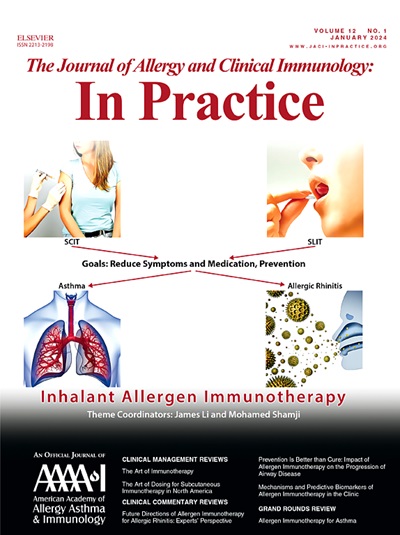Should Patients With a Large Local Reaction Be Offered Venom Immunotherapy? A Pro-Con Debate
IF 8.2
1区 医学
Q1 ALLERGY
Journal of Allergy and Clinical Immunology-In Practice
Pub Date : 2025-01-01
DOI:10.1016/j.jaip.2024.06.043
引用次数: 0
Abstract
Insect stings can cause large local reactions (LLRs) that are IgE-mediated and associated with considerable morbidity. A risk for systemic reactions including anaphylaxis to subsequent stings has been reported and is often noted by patients and health care providers. Guidelines do not recommend venom immunotherapy (VIT) for LLRs based on the relatively low risk of anaphylaxis, but this is debated in this review. On the pro side: the risk of anaphylaxis may be higher than reported in the limited literature, especially in patients who had only 1 LLR; new species with more potent stings are spreading into new areas; the quality of life can be markedly impaired by LLRs; and VIT is generally safe and highly effective. On the con side: LLRs are benign, stings occur infrequently, VIT has significant cost, systemic reactions occur more often to VIT than to stings in patients with LLRs, and Food and Drug Administration approval and published guidelines do not recommend VIT for LLRs. In practice, shared decision-making is appropriate to incorporate knowledge of the natural history and known high-risk factors in the context of the patient’s personal values and preferences.
局部反应大的患者是否应该接受 VIT?正反方辩论
昆虫蜇伤可引起 IgE 介导的大面积局部反应(LLRs),发病率相当高。有报道称,患者和医疗服务提供者经常注意到蛰伤后可能出现全身反应,包括过敏性休克。鉴于过敏性休克的风险相对较低,指南并不建议对长尾蛙进行毒液免疫疗法(VIT),但本综述对此进行了辩论。正方观点:过敏性休克的风险可能高于有限文献中的报道,尤其是在仅有过一次长尾蝇螫伤的患者中;螫伤毒性更强的新物种正在向新的地区扩散;长尾蝇螫伤可能会严重影响生活质量;VIT 通常是安全、高效的。反方LLR 是良性的;蜇伤不常发生;VIT 成本高昂;在 LLR 患者中,VIT 比蜇伤更常发生全身反应;FDA 批准和已公布的指南不建议对 LLR 使用 VIT。在实践中,根据患者的个人价值观和偏好,结合对自然病史和已知高危因素的了解,共同决策是适当的。
本文章由计算机程序翻译,如有差异,请以英文原文为准。
求助全文
约1分钟内获得全文
求助全文
来源期刊

Journal of Allergy and Clinical Immunology-In Practice
ALLERGYIMMUNOLOGY-IMMUNOLOGY
CiteScore
11.10
自引率
9.60%
发文量
683
审稿时长
50 days
期刊介绍:
JACI: In Practice is an official publication of the American Academy of Allergy, Asthma & Immunology (AAAAI). It is a companion title to The Journal of Allergy and Clinical Immunology, and it aims to provide timely clinical papers, case reports, and management recommendations to clinical allergists and other physicians dealing with allergic and immunologic diseases in their practice. The mission of JACI: In Practice is to offer valid and impactful information that supports evidence-based clinical decisions in the diagnosis and management of asthma, allergies, immunologic conditions, and related diseases.
This journal publishes articles on various conditions treated by allergist-immunologists, including food allergy, respiratory disorders (such as asthma, rhinitis, nasal polyps, sinusitis, cough, ABPA, and hypersensitivity pneumonitis), drug allergy, insect sting allergy, anaphylaxis, dermatologic disorders (such as atopic dermatitis, contact dermatitis, urticaria, angioedema, and HAE), immunodeficiency, autoinflammatory syndromes, eosinophilic disorders, and mast cell disorders.
The focus of the journal is on providing cutting-edge clinical information that practitioners can use in their everyday practice or to acquire new knowledge and skills for the benefit of their patients. However, mechanistic or translational studies without immediate or near future clinical relevance, as well as animal studies, are not within the scope of the journal.
 求助内容:
求助内容: 应助结果提醒方式:
应助结果提醒方式:


